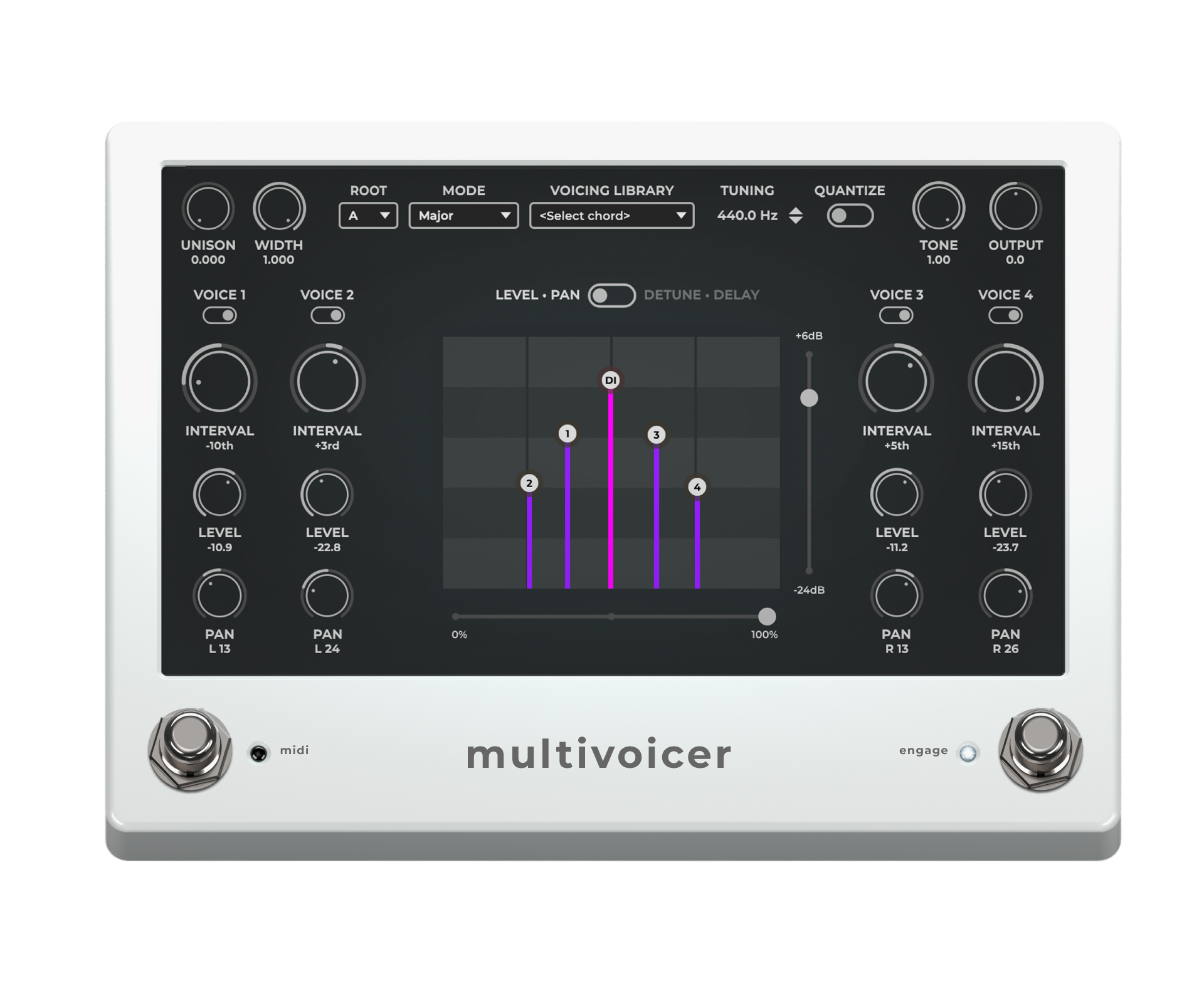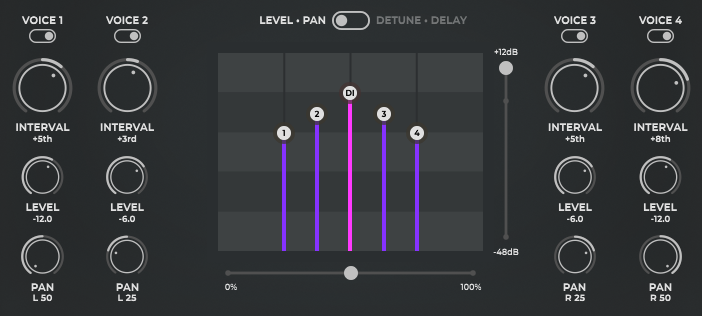The Multivoicer is an intelligent pitch shifter device that adds up to four voices, higher or lower in pitch, simultaneously.
This device is intended to work properly with monophonic sources. If you play multiple notes or bigger chords while the pedal is engaged, the behavior of the voices might be erratic.
- MIDI SWITCH: Click to activate/deactivate the MIDI mode.
- ENGAGE BYPASS SWITCH: Click to activate/deactivate the Multivoicer pedal.
MIDI Mode
A MIDI keyboard can be used to control the pitched voices.
If you are using the standalone version, go to the audio settings and enable your MIDI Input Device by clicking on it. Within a DAW, assign a MIDI track output to the plugin to make it work. The voices will be automatically assigned to the keys as they are
pressed.
The INTERVAL knobs and VOICE switches will be disabled when the MIDI mode is activated.
Voice Arranger
Deactivate the MIDI mode to enable the INTERVAL and VOICE controls.
This section is made of four columns with dedicated controls. The Level, Pan, Detune, Delay, and Pitch parameters can be adjusted for each voice independently. The parameter values are displayed in an X/Y diagram which is also mouse-controllable.
- VOICE BYPASS SWITCHES: Click to activate/deactivate the voices.
- LEVEL-PAN/DETUNE-DELAY SWITCH: Click to switch the parameter view between LEVEL-PAN or DETUNE-DELAY controls.
- INTERVAL KNOBS: Control which intervals will be generated from the notes of the dry input signal, based on the key and scale currently selected.
- LEVEL KNOBS: Adjust the output level of the voices.
- PAN KNOBS: Control the output panning of the voices.
- DETUNE KNOBS: Change the pitch of the voices (+/- 50 cents).
- DELAY KNOBS: Delay the voices up to 400 milliseconds.
- X/Y SLIDERS: Determine the parameter range of the voices. Useful for moving all the voices at once.
- DRAG TO POSITION: You can also control the voice’s parameters by clicking the numbered circles and dragging them to the desired spot. The values will be reflected on the knobs and vice versa.
Header Controls
This section contains global controls that affect the behavior of the voices.
- UNISON KNOB: Determines how many copies of the interval are generated per voice. Set the value as 0.000 to use single intervals per voice.
- WIDTH KNOB: Stereo imager for the voices. Increase the value to enhance the stereo separation of the voice copies.
- ROOT MENU: Dropdown menu for selecting the root note. It establishes the tonality of the scale selected.
- MODE MENU: Dropdown menu for selecting the scale.
- VOICING LIBRARY MENU: Dropdown menu for selecting chord voicings. It distributes the voices’ order depending on the ROOT and MODE selected (Major and Minor modes only).
- TUNING: Frequency selector. It affects the pitch of the voices.
- QUANTIZE SWITCH: Quantizes (or automatically corrects) the pitch of the voices to the nearest semitone position. The voices are adjusted to the closest notes of the key and scale currently selected.
- TONE KNOB: Controls the mid and high frequencies of the voices.
- OUTPUT KNOB: Controls the overall output level of the Multivoicer pedal.
Voicing Library
“Voicing” refers to the placement of the notes in a chord structure. The notes of a chord can appear in a different order or in a different set of octaves. This principle applies to all kinds of chords.
How to use it?
The VOICING LIBRARY includes the most popular chord voicings. Click on them to modify the VOICE BYPASS switches and the INTERVAL knobs (Depending on the ROOT and MODE selected). The Voicing Library menu will be disabled when the Chromatic Mode is selected.
Chord Voicings List
- TRIADS: Chords made up of three tones.
- SEVENTH CHORDS: Chords made up of four tones.
- DROPS: Drop voicings are formed by dropping the note next to the highest note, or voice, to the lowest note of the chord.
- TENSIONS: Refers to extra notes that are not part of a triad or a seventh chord.
- TONE CLUSTERS: A combination of dissonant musical tones that are very close together (minor or major seconds).
- OTHERS: A selection of suspended voicings, power chords, and unisons.





